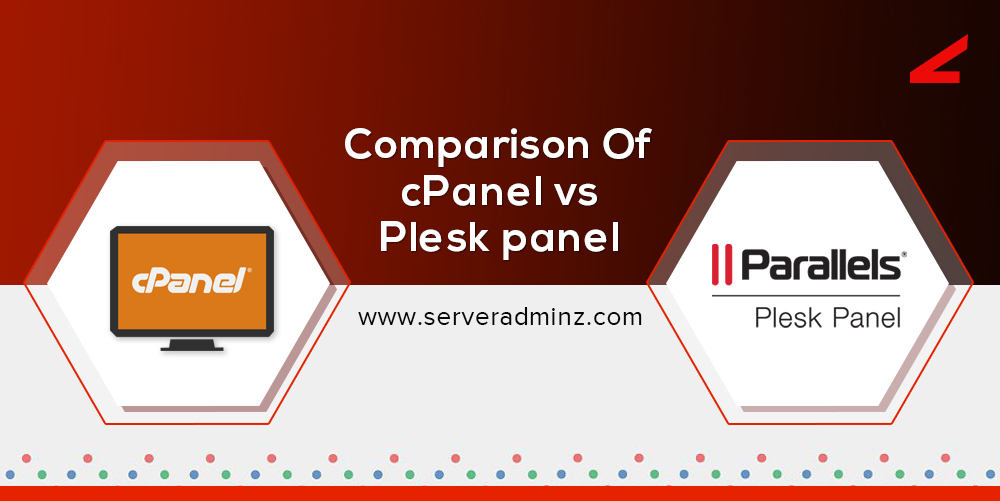cPanel
cPanel is a webhosting control panel mainly used for hosting websites. It provides a graphical user interface to host a web site. It is easy to manage and create email accounts, configure addon domains/subdomains,monitor statistics, creating backups, and performing cron jobs.
Plesk Panel
Plesk panel is a Linux based hosting control panel used for hosting websites. Plesk help us to set up new websites, manage reseller accounts, e-mail accounts, and DNS entries through a web-based interface.The latest version of Plesk is called Plesk Onyx. (version 17).
Comparison of Cpanel and Plesk panel
Client web interface
CPanel has a straightforward and graphical interface that enables you to get to and oversee a large portion of the highlights (PGP keys, FTP accounts, mailing records and that’s just the beginning) from the front end. It has a command line and offers API based access that robotizes organization tasks.Port numbers to access cPanel are secured port 2083 and non secured port 2082.
Plesk Onyx gives an interface and ready to code condition with PHP, JavaScript, Perl, Ruby, Python, Java and .NET bolster. It is sorted out in various areas that encourages speedier working and spares your significant time. It gives part based access, over all the devices. Port numbers to access plesk are Secured port number 8443 and nonsecured port number 8880.
How to access Cpanel and Plesk panel
Cpanel Access
We can access the cPanel in different ways.They are
Method-1
If you are familiar with your server name, here is the best method: https://ServerName:2083
Method-2
Use https and your server’s IP address, followed by the secure port number:https://Server-IP-Address:2083
Method-3
Use https and your domain name, followed by the secure port number:https://domain.com:2083
Plesk Access
We can access the cPanel in different ways,They are
Method -1
We can log into Plesk by pointing our browser to https://domain:8443
Method -2
Use https and your server’s IP address, followed by the secure port number:https://Server-IP-Address:8443
Method-3
Use https and server name: https://ServerName:8443
This will take you to a login screen where you can enter your username and password.
Operating system support
cPanel is a Linux based control panel that functions either as a VPS or a dedicated server. It is perfect with CentOS, Cloud Linux and Red Hat working frameworks yet it doesn’t bolster Windows stage.
Plesk Onyx underpins not just Windows OS (Windows Server 2008 R2, Windows Server 2012, Windows Server 2012 R2) yet in addition adds different Linux distributions to its rundown of opearating system’s support Debian, Ubuntu, Virtuozzo, CloudLinux 6 and 7 and Red Hat Enterprise 6 and 7.
Reseller support
cPanel supports resellers and help the users to manage name servers, IP pools and individual user account.
The Plesk Onyx panel does not support reseller, but it allows us to build a reseller profile by using the “Service Plans” feature.
We can create individual FTP accounts and we can limit access to specific folders in both Cpanel and Plesk panel.In cPanel, we can create a database and create a database user and can add the database user to the database and give them permissions. On the other hand In Plesk, we can create a database (MySQL or MS SQL) and create a database user for that database.
cPanel security features include
password-protected directories
IP address denials
SSL/TLS for e-commerce companies
GnuPG key settings for encryption
Plesk security features include
Active directory integration
Social media authentication
Inbound and outbound anti-spam services
Fail2Ban intrusion prevention system
Similarities
Both Cpanel and plesk have robust security options
Both are powerful administration tools
Both provide command line access
Domain name system management:Domain renewal, DNS editing, domain forwarding, subdomain management, and registering new domains.
Email system management:Setting up new email accounts, email forwarders, and email spam filters.
FTP management:User account admin, password management, and file system quotas
Web-based file system access
SSH user/key management
Database management
Backup management
Applicationss:WordPress, Joomla, Drupal, ZenCart, etc.
” margin_top=”50px” margin_bottom=”” animation_type=”slide” animation_direction=”left” animation_speed=”0.3″ class=”” id=””]






Leave A Comment
You must be logged in to post a comment.